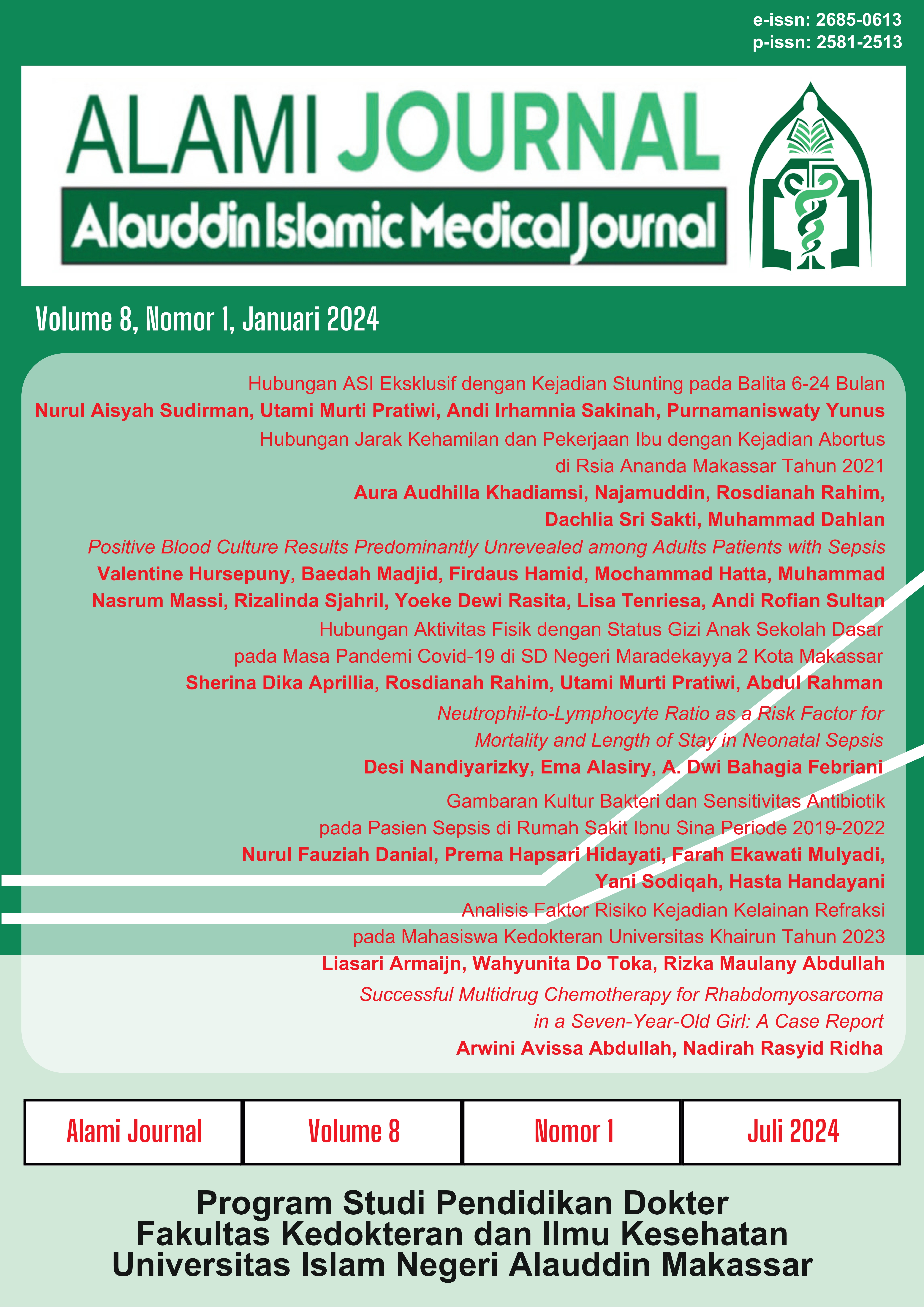The Relationship between Exclusive Breastfeeding and Stunting Incidence in Children Aged 6-24 Months
Abstract
Stunting is currently still a problem in Makassar. Incidence stunting from Riskesdas data in Makassar is 25.9% and stunting data at Kassi Kassi Health Center is 22.92%, this figure is still above the stunting limit according to World Health Organization, which is 20%. One of the causes of stunting is mainly influenced by nutritional intake, exclusive breastfeeding for six months because breast milk is needed during the growth period. The purpose of this study was to determine the relationship between exclusive breastfeeding and the incidence of stunting in toddlers aged 6-24 months. The research design used was observational analytic with a cross-sectional approach. This research was conducted in the working area of the Kassi Kassi Health Center from November to December 2021. The sampling technique used was purposive sampling. A total of 90 samples in this study that met the inclusion and exclusion criteria were then analyzed by bivariate test using the Pearson Chi-Square test. The findings from this study were stunted by as many as 55 respondents (61.1%). The study also found that more were getting exclusive breastfeeding as many as 55 respondents (61.1%). The incidence of stunting showed a higher proportion in infants aged 6-24 months without exclusive breastfeeding (p-value 0.001). This indicates that there is a relationship between exclusive breastfeeding and the incidence of stunting in toddlers at Kassi-Kassi Health Center.
References
Kementerian PPN/Bappenas. Pembangunan Gizi di Indonesia [Internet]. 2019. Available from : https://www.bappenas.go.id/files/1515/9339/2047/FA_Preview_HSR_Book04.pdf
Kementerian Kesehatan RI. Buletin Stunting. Kementerian Kesehatan RI. 2018;301(5):1163–78.
World Health Organization. Nutrition Landscape Information System (NLIS). Geneva: Country Profile Indicators Interpretation Guide; 2010.
Titaley CR, Ariawan I, Hapsari D, Muasyaroh A, Dibley MJ. Determinants of the Stunting of Children in Indonesia : A Multilevel Analysis of the 2013 Indonesia Basic Health Survey. Nutrients. 2019;11(5):1106-18.
Sentana LF, Hrp JR, Hasan Z. Faktor-Faktor Yang Berhubungan Dengan Kejadian Stunting Pada Anak Usia 12-24 Bulan Di Kelurahan Kampung Tengah Kecamatan Sukajadi Pekanbaru. Jurnal Ibu dan Anak. 2018;6(1):1-9.
Darina D. Hubungan Berkelanjutan Pangan Keluarga dan Pengetahuan Ibu Tentang Grafis Pertumbuhan Tentang Status Gizi Baduta di Desa Pamboborang. Awal Bros. 2020;1(2).
Tim Nasional Percepatan Penanggulangan Kemiskinan RI. 100 Kabupaten/kota prioritas untuk intervensi anak kerdil (stunting). Jakarta: Sekretariat Wakil Presiden Republik Indonesia; 2017.
Ballard O, Morrow AL. Human Milk Composition: Nutrients and Bioactive Factors. Pediatric Clinics. 2013 Feb;60(1):49–74.
Derso T, Tariku A, Biks GA, Wassie MM. Stunting, wasting and associated factors among children aged 6-24 months in Dabat health and demographic surveillance system site: A community based cross-sectional study in Ethiopia. BMC Pediatrics. 2017;17:96
Resti E, Wandini R, Rilyani R. Pemberian Makanan Pendamping Asi (Mp-Asi) Berhubungan Dengan Kejadian Stunting Pada Balita. Jurnal Kebidanan Malahayati. 2021;7(2):274–8.
Rahayu A, Yulidasari F, Putri AO, Anggraini L. Stunting dan Upaya Pencegahannya. 1st ed. Yogyakarta: CV Mine.2018.
Hikmahrachim HG, Rohsiswatmo R, Ronoatmodjo S. Efek ASI Eksklusif terhadap Stunting pada Anak Usia 6-59 bulan di Kabupaten Bogor tahun 2019. Jurnal Epidemiologi Kesehatan Indonesia. 2019;3(2):77–82.
Latifah AM, Purwanti LE, Sukamto FI. Hubungan Pemberian ASI Eksklusif dengan Kejadian Stunting Pada Balita 1-5 Tahun. Health Sciences Journal. 2020;4(1):131-42.
Kementerian Kesehatan RI. Manfaat ASI Eksklusif untuk Ibu dan Bayi [Internet]. 2018. Available from : https://upk.kemkes.go.id/new/ketahui-manfaat-asi-eksklusif-bagi-bayi-dan-ibu.
Nugraheni D, Nuryanto N, Wijayanti HS, Panunggal B, Syauqy A. ASI Eksklusif Dan Asupan Energi Berhubungan Dengan Kejadian Stunting Pada Usia 6 – 24 Bulan di Jawa Tengah. Journal of Nutrition College. 2020;9(2):106–13.
Fitri L. Hubungan BBLR dan ASI Eksklusif dengan Kejadian Stunting di Puskesmas Lima Puluh Pekanbaru. Jurnal Endurance. 2018;3(1):131–7.
Putri AD, Ayudia F. Hubungan Pemberian ASI Eksklusif dengan Kejadian Stunting Pada Anak Usia 6-59 Bulan di Kota Padang. Jurnal Kesehatan Medika Saintika. 2020;11(1):33–8.
Mohsen AHA, Sallam S, Ramzy MM, Hamed EK. Investigating the Relationship between Insulin-like Growth Factor-1 (IGF-1) in Diabetic Mother’s Breast Milk and the Blood Serum of Their Babies. Electronic Physician. 2016 Jun 25;8(6):2546–50.
Copyright (c) 2024 Nurul Aisyah Sudirman

This work is licensed under a Creative Commons Attribution-NonCommercial-ShareAlike 4.0 International License.
Once an article was published in the journal, the author(s) are: granted to the journal right licensed under Creative Commons License Attribution that allows others to share the work with an acknowledgement of the work's authorship. permitted to publish their work online in third parties as it can lead wider dissemination of the work. continue to be the copyright owner and allow the journal to publish the article with the CC BY-NC-SA license receiving a DOI (Digital Object Identifier) of the work.


